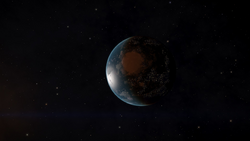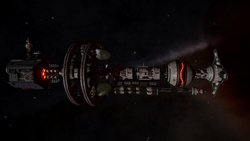The Galactic Cooperative of Worlds, commonly known as GalCop, was an interstellar superpower that arose in the Old Worlds region of the Core Systems in 2696. Based out of the Lave system, GalCop was a trade organisation that mainly concerned themselves with space and station-based activity, and did not take part in planetary affairs,[1] even going so far as to isolate themselves economically from the Federation and Empire.[2]
GalCop played a significant role in the first conflict against the Thargoids in 3125, but the focus on military involvement at the expense of trade left it economically exhausted, allowing the other two superpowers to lure away existing and prospective member worlds. Combined with a corruption scandal that disgraced officials at the highest levels, GalCop diminished rapidly before dissolving its charter in 3174.[2]
History[]
A vision of self-reliance[]
In 2483, a number of colonies within the Old Worlds region banded together in response to the heavy Imperial presence along their borders, forming the Old Worlds Coalition, a loose mutual defence pact. The Coalition relied on a merchant reserve navy for its defense, but an Imperial incursion in 2498 strong-armed the Coalition into disbanding its navy and restricting itself purely to trade and exploration. While the Old Worlds subsequently prospered by becoming the galaxy's chief producer of hydrogen fuel, Coalition policies suffered a humiliating failure in 2690 when the people of Riedquat violently overthrew their Coalition-enforced, off-world government and descended into an anarchy that would last for centuries. In response to Riedquat's collapse, Coalition officials sought to revise their policies to prevent a similar disaster from ever happening again.[2]
The result of this restructuring was the Galactic Cooperative of Worlds, which was established in August of 2696 with the ratification of the official charter under the first Galactic Cooperative Chief Executive Officer, Hahris Moersven. The core tenets of GalCop were the preservation of member worlds' economic and political independence, minimal membership requirements, free trade, and mutual defense. Unlike the more aggressive Federation and Empire, GalCop emphasized the need for cooperation and expansion through peaceful means.[2]
GalCop also implemented an isolationist economic policy that broke off all trade with non-member worlds, a move which the Federation and Empire condemned as potentially destabilising for the galactic economy. After its charter was enacted, GalCop never responded to the last edict sent to it by the Empire, which was a warning against any attempts by the Cooperative to expand into Imperial territory.[2]
The new age of space travel[]

Lave was the capital planet of GalCop
GalCop immediately attracted a wave of entrepreneurs and innovative talent, spurring countless new scientific and technological advancements. In 2699, Whatt and Pritney Shipyards revealed a prototype for the Python, a ship with a revolutionary modular design. Released in 2700, the Python paved the way for a new age of low-cost, accessible space travel for independent pilots, breaking new ground in a field that had long been dominated by slower, massive transport vessels that only large corporations could afford.[2]
Later that century, GalCop centralised its government in the Lave system, establishing new administrative facilities on both Planet Lave and Lave Station and dividing its capital between them. A pilot training academy was also established to train new pilots from across the Cooperative's member worlds.[2]
GalCop was also responsible for the creation and proliferation of the Coriolis station design.[2]
Threats from beyond[]
In 2849, the first recorded contact between humans and Thargoids is believed to have occurred within GalCop territory.[3] GalCop had been documenting multiple starship disappearances and hyperdrive malfunctions both within its territory and near the Pleiades Nebula since the 2810's, but it was not until 2849 that the first footage of an "encounter" emerged. One blurry image appeared to show a section of mottled hull with the word "THARG" on it, causing the media to coin the term "Thargoid" as a name for the possible aliens. However, no conclusive proof of the Thargoids' existence was obtained, and they faded into folklore.[2]
The first official, verified contact with the Thargoids occurred in 3125, coming on the heels of an incident two years earlier in which GalCop had discovered the wreckage of two ships destroyed by unknown laser weapons in its territory.[2] Independent pilots claimed that they were being pulled out of hyperspace and attacked by octagonal ships. Those who survived the experience were convinced they had encountered an alien species, and named the aliens "Thargoids" after the 29th century incidents. As the news spread, leaked Federal intelligence reports indicated that the Thargoid attacks were likely provoked by human hostility; colonists in the Veliaze system had apparently come into contact with a Thargoid deputation and assaulted it out of ignorance shortly before the attacks began.[4][2]
GalCop, along with the Federation and the Intergalactic Naval Reserve Arm, played a principal role in defending human space from the Thargoids during the ensuing conflict. While INRA tracked the Thargoids and developed the technology to stop them, Federal and Galactic Navy forces patrolled vulnerable systems. GalCop reassigned numerous trade vessels to perform military duties.[2] In the course of the First Thargoid War, GalCop also captured a number of Thargoid spacecraft, which would later end up in the Alliance's hands. The Alliance was able to reverse-engineer them to produce the first Frame Shift Drive prototypes by the 3270's.[1] Eventually, the Thargoid conflict came to an end as the Thargoids departed from human space, ostensibly defeated by INRA's deployment of a devastating biological weapon.[2]
Project Equinox[]

GCS Sarasvati
According to the logs of the Megaship GCS Sarasvati, the First Thargoid War ended in 3151. In the aftermath, GalCop set up a series of deep space monitoring stations, one of which was the GCS Sarasvati, to watch for a resurgent Thargoid threat. This initiative was called Project Equinox. However, by December 27, 3155, no Thargoid presence had been detected whatsoever and members of the project questioned its usefulness. By August 16, 3172, GalCop had become weakened and fractured, and Project Equinox was shut down. Unfortunately, this occurred just as project lead Dr. Cassandra Lockhart discovered that the Thargoids had been sowing the seeds for their future return all along, and her warnings were ignored.[5]
Decline and dissolution[]
The First Thargoid War had the unforeseen effect of ushering in GalCop's decline. As a result of re-purposing trading ships for war, GalCop was unable to sufficiently replenish its economy during the fighting and quickly exhausted it. While the Federation and Empire prospered and innovated between 3125 and 3145, GalCop stagnated and fell behind competitively. The other two superpowers began luring existing and prospective member worlds away from GalCop, worsening GalCop's economic deterioration.[2]
GalCop CEO Naris Ellison then contracted and succumbed to a rare degenerative disease in 3149. She was succeeded by her deputy, William Henderick, who promised to continue Ellison's efforts to restore GalCop to prominence, but Henderick was soon implicated in Ellison's death and replaced by acting CEO Simmone Hendry. Hendry's position was made permanent in 3153 in response to rising discontent among GalCop member worlds. An investigation into Ellison's murder, as well as corruption and illegal activity within GalCop's administration, was begun in 3162 under the direction of Nance Lightoller, who endured numerous death threats and assassination attempts. The investigation was completed in 3167, and Henderick and five co-conspirators were confirmed to be responsible for Ellison's death. The investigation also brought to light rampant misreporting of GalCop's stability and colony management, along with policies that isolated and deceived the planetary populations of member worlds.[2]
By 3170, GalCop had been reduced to only 11 member worlds, all of which were located in the Old Worlds region. The formerly formidable organisation found itself reduced to the same trade routes that its colonies first depended upon centuries ago when they were being established. CEO Simmone Hendry sold off most of GalCop's assets to the Federation and Empire in exchange for access to their trade routes to keep GalCop afloat, but the effort was in vain and decline continued. On August 19, 3174, Hendry formally rescinded the Galactic Cooperative of Worlds' charter.[2] The demise of GalCop led to the decline of the once-prosperous Old Worlds, and fostered the eventual rise of the Alliance in 3230.[1]
Trivia[]
- The Galactic Cooperative of Worlds (then abbreviated as "GalCop") was introduced in the original Elite games, where it was a space-based multi-species faction that served as the main government and police force. Like its incarnation in Elite Dangerous, GalCop held jurisdiction over space and stations, but not planets. In subsequent games, the organization rebranded itself as Interpol, but then fell into obscurity due to the Federation and the Empire creating their own police forces.
